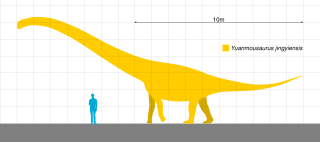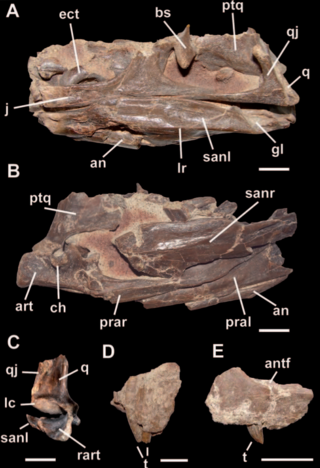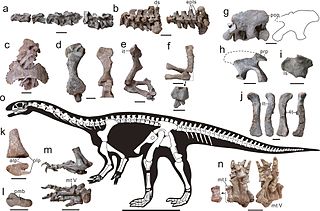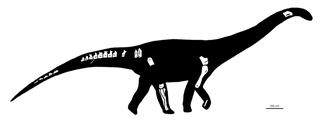
Argentinosaurus is a genus of giant sauropod dinosaur that lived during the Late Cretaceous period in what is now Argentina. Although it is only known from fragmentary remains, Argentinosaurus is one of the largest known land animals of all time, perhaps the largest, measuring 30–35 metres (98–115 ft) long and weighing 65–80 tonnes. It was a member of Titanosauria, the dominant group of sauropods during the Cretaceous. It is widely regarded by many paleontologists as the biggest dinosaur ever, and perhaps lengthwise the longest animal ever, though both claims have no concrete evidence yet.

Huabeisaurus was a genus of dinosaur from the Late Cretaceous. It was a sauropod which lived in what is present-day northern China. The type species, Huabeisaurus allocotus, was first described by Pang Qiqing and Cheng Zhengwu in 2000. Huabeisaurus is known from numerous remains found in the 1990s, which include teeth, partial limbs and vertebrae. Due to its relative completeness, Huabeisaurus represents a significant taxon for understanding sauropod evolution in Asia. Huabeisaurus comes from Kangdailiang and Houyu, Zhaojiagou Town, Tianzhen County, Shanxi province, China. The holotype was found in the unnamed upper member of the Huiquanpu Formation, which is Late Cretaceous (?Cenomanian–?Campanian) in age based on ostracods, charophytes, and fission-track dating.

Goyocephale is an extinct genus of pachycephalosaurian ornithischian that lived in Mongolia during the Late Cretaceous about 76 million years ago. It was first described in 1982 by Altangerel Perle, Teresa Maryańska and Halszka Osmólska for a disarticulated skeleton with most of a skull, part of the forelimb and hindlimb, some of the pelvic girdle, and some vertebrae. Perle et al. named the remains Goyocephale lattimorei, from the Mongolian гоё (goyo), meaning "decorated", and the Ancient Greek κεφαλή (kephale), for head. The species name honours Owen Lattimore.

Klamelisaurus is a genus of herbivorous sauropod dinosaur from the Middle Jurassic Shishugou Formation of China. The type species is Klamelisaurus gobiensis, which was named by Zhao Xijin in 1993, based on a partial skeleton discovered in 1982 near the abandoned town of Jiangjunmiao. Zhao described Klamelisaurus as the only member of a new subfamily, Klamelisaurinae, among the now-defunct primitive sauropod order Bothrosauropodoidea. Since Zhao's description, Klamelisaurus received limited attention from researchers until Andrew Moore and colleagues redescribed it in 2020.

Yuanmousaurus was a sauropod dinosaur from the Middle Jurassic period of China. It is known from incomplete remains, recovered in 2000 from the Zhanghe Formation in Yuanmou County in Yunnan Province. Yuanmousaurus was a relatively large sauropod and may have reached about 17 meters (56 ft) in length. It was a basal member of the Sauropoda, but its exact systematic position is unclear. A recent study placed Yuanmousaurus within the family Mamenchisauridae. It may be a dubious genus. The only and type species was Yuanmousaurus jiangyiensis.

Jesairosaurus is an extinct genus of early archosauromorph reptile known from the Illizi Province of Algeria. It is known from a single species, Jesairosaurus lehmani. Although a potential relative of the long-necked tanystropheids, this lightly-built reptile could instead be characterized by its relatively short neck as well as various skull features.

Bicentenaria is an extinct genus of carnivorous coelurosaurian theropods which lived during the early Late Cretaceous (Cenomanian) Candeleros Formation of Argentina. It contains the type species, B. argentina.

Trinisaura is a genus of ornithopod dinosaur that lived during the late Campanian stage of the Upper Cretaceous, around 73 to 72 million years ago in what is now James Ross Island off the coast of northern Antarctica near Patagonia. It is known from a single, incomplete postcranial skeleton that includes several vertebrae, a partial pelvis, and nearly complete right hindlimb. The fossils were collected in 2008 by paleontologists Juan Moly and Rodolfo Coria from the sandstone of the Snow Hill Island Formation. It remained undescribed in the collections of the Museo de La Plata until its description by Coria and colleagues in 2013, being the basis of the novel genus and species Trinisaura santamartaensis. The genus name is to commemorate the efforts of Argentine geologist Trinidad "Trini" Diaz and the Latin root -sauros, meaning "lizard". The species name is after Santa Marta Cove, where the fossils were collected.
This glossary explains technical terms commonly employed in the description of dinosaur body fossils. Besides dinosaur-specific terms, it covers terms with wider usage, when these are of central importance in the study of dinosaurs or when their discussion in the context of dinosaurs is beneficial. The glossary does not cover ichnological and bone histological terms, nor does it cover measurements.
Eousdryosaurus is a genus of basal iguanodontian dinosaur known from a partial skeleton discovered in Upper Jurassic rocks in western Portugal. The type, and only species, is Eousdryosaurus nanohallucis, named and described in 2014.
Nundasuchus is an extinct genus of crurotarsan, possibly a suchian archosaur related to Paracrocodylomorpha. Remains of this genus are known from the Middle Triassic Manda beds of southwestern Tanzania. It contains a single species, Nundasuchus songeaensis, known from a single partially complete skeleton, including vertebrae, limb elements, osteoderms, and skull fragments.

Morrosaurus is an extinct genus of herbivorous elasmarian dinosaur that lived in the late Cretaceous in Antarctica. The only known species is the type Morrosaurus antarcticus.

Douzhanopterus is an extinct genus of monofenestratan pterosaur from the Late Jurassic of Liaoning, China. It contains a single species, D. zhengi, named by Wang et al. in 2017. In many respects, it represents a transitional form between basal pterosaurs and the more specialized pterodactyloids; for instance, its tail is intermediate in length, still being about twice the length of the femur but relatively shorter compared to that of the more basal Wukongopteridae. Other intermediate traits include the relative lengths of the neck vertebrae and the retention of two, albeit reduced, phalanx bones in the fifth digit of the foot. Phylogenetically, Douzhanopterus is nested between the wukongopterids and a juvenile pterosaur specimen from Germany known as the "Painten pro-pterodactyloid", which is similar to Douzhanopterus in many respects but approaches pterodactyloids more closely elsewhere.

Xingxiulong is a genus of bipedal sauropodiform from the Early Jurassic of China. It contains a single species, X. chengi, described by Wang et al. in 2017 from three specimens, two adults and an immature individual, that collectively constitute a mostly complete skeleton. Adults of the genus measured 4–5 metres (13–16 ft) long and 1–1.5 metres tall. Phylogenetic analysis suggests that Xingxiulong is most closely related to its contemporary Jingshanosaurus, although an alternative position outside of both the Sauropodiformes and Massospondylidae is also plausible.
Magnamanus is an extinct genus of herbivorous iguanodontian dinosaur that lived during the Early Cretaceous in what is now Spain in the Golmayo Formation. It contains a single species, Magnamanus soriaensis.

Vouivria is a genus of herbivorous sauropod dinosaur, belonging to the Brachiosauridae, that lived in the area of present France during the Late Jurassic. The type species is Vouivria damparisensis.

Corythoraptor is a genus of oviraptorid dinosaur from the late Maastrichtian Nanxiong Formation of South China. It contains one species, C. jacobsi, known from a single well-preserved skeleton, and named after paleontologist Louis L. Jacobs. It bears a tall crest similar to that of the modern cassowary, and possibly had a similar functionality of display and resonance to detect lower-frequency sounds.

Nullotitan is a genus of lithostrotian titanosaur from the Chorrillo Formation from Santa Cruz Province in Argentina. The type and only species is Nullotitan glaciaris. It was a contemporary of the ornithopod Isasicursor which was described in the same paper.
Yuanjiawaornis is an extinct genus of large enantiornithean bird known from the early Cretaceous of present-day China. It is monotypic, with only type species Y. virisosus known.

Stegouros is a genus of ankylosaurian dinosaur from the Late Cretaceous Dorotea Formation of southern Chile. The genus contains a single species, Stegouros elengassen, known from a semi-articulated, near-complete skeleton.


























